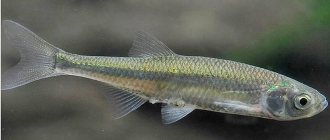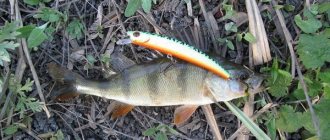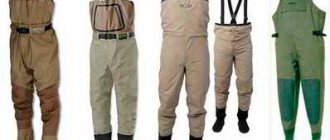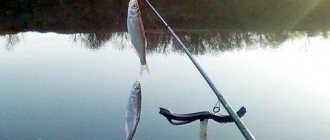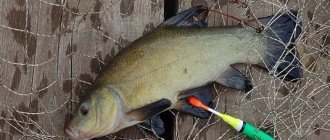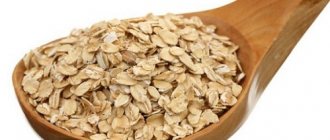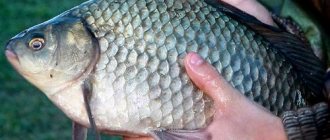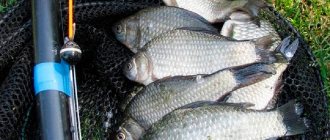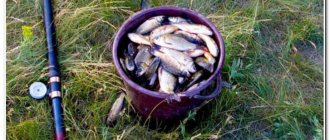Catching pike perch with live bait is attractive for its results throughout the year, regardless of the condition of the reservoir. Even during times of passive behavior of the predator in the hot summer months and months of deep winter, this method of fishing will be in demand due to its catchability in relation to fishing with the use of artificial baits, which requires a definitely high activity of the fish. Hunting for pike perch with live bait is not as dynamic as with a spinning rod, but for some fishermen this particular ambush method gives pleasure in planning a fishing strategy, selecting a place and time for fishing, and, of course, catching live bait.
A variety of live bait gear allows you to fish for pike perch from a boat, from the shore and from the ice of a reservoir in the winter. The technology of such fishing is simple and does not require specialized and expensive equipment. This article will discuss the method of catching pike perch using live bait, the most popular gear for such hunting, and promising live bait baits and their extraction.
Advantages and disadvantages of this fishing method
Catching pike perch with fry is not as expensive as spinning fishing, which requires expensive baits and the selection of a special fishing rod, the parameters of which depend on the fishing conditions in the reservoir. You can assemble the equipment from universal fishing accessories using common and inexpensive materials. In addition, for pike perch live bait hunting there is no strict connection to the methods of making rigs; they are similar to the equipment and ties used in catching pike.
An important advantage is the year-round use of this technique, as well as the ability to select a fishing method for certain weather conditions. Another advantage will be the possibility of stationary installation of gear for catching pike perch with live bait for a long period. The fisherman can only insure the gear against being pulled into the water by fish and periodically visit the fishing spot to check and change bait material and collect prey. And, of course, it is worth noting the high effectiveness of the method . After all, a well-chosen place and equipment effectively selected for fishing conditions almost always guarantee ultimate success.
The equipment for catching pike perch with live bait also has disadvantages, which some anglers attribute to the low dynamics of the hunt, 100% death of the caught fish, since the trophy is injured by hooks and is not combined with its life, which has recently not been welcomed by anglers fishing on the principle of catching - let go. To all of the above, we can add that additional time will definitely be required to search for and capture live bait material and subsequently ensure its safety, which entails the use of additional equipment and the implementation of certain measures.
Gear selection
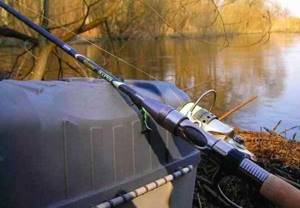
When catching pike perch from a boat, 3 types of gear are used:
- A side fishing rod up to 1 meter long with an inertial reel on which a monofilament line 0.3-0.4 mm thick is wound. A bright nod made of a flat spring or thick cable insulation attached to the tip of a fishing rod is used as a bite alarm.
- 210-centimeter jig spinning rod with dough up to 30 grams, glued in bright tip, spinning reel size 2500-3000. A braided cord with a thickness of 0.12-0.14 mm is used as the main fishing line in such gear.
- Twitching hard spinning rod 180-210 cm long with a reel with a line capacity of 3000, equipped with a cord of 0.10-0.12 mm
In both types of gear, a 30-centimeter piece of fluorocarbon fishing line with a thickness of 0.3-0.35 mm with a swivel and carabiner is used as a leash.
Attention. The use of a metal leash in vertical fishing gear is practiced in places where large trophy pike stand in the pits along with pike perch. In all other cases, steel leaders worsen the performance of the bait, reduce the sensitivity of the equipment, and make it more noticeable.
What kind of bait should it be?
The choice of live bait for catching pike perch is based on the food supply in the fished body of water.
Important! According to its physiology, a fanged predator has a narrow mouth incapable of swallowing large fish, so the victims of pike perch are small fish that are spindle-shaped and slender in body shape, rarely exceeding the size of 10–12 cm in length.
On large rivers and lakes, the favorite food of pike perch is bleak . The fanged gudgeon also does not disdain gudgeons, gobies, dace and roaches. Loaches, spined loaches, crucian carp, minnows, chubs and roaches are used as live baits. In some cases, the use of bream and silver bream will be effective.
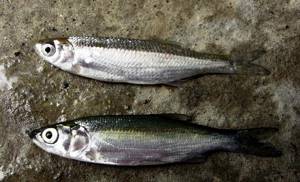
Bleak
They try to get live bait at the place where the predator is being hunted. The bait, which is familiar in shape and appearance, increases the number of bites and the size of the trophy, without causing unnecessary suspicion and fear in the predator about the live bait material.
Choosing live bait for catching pike perch
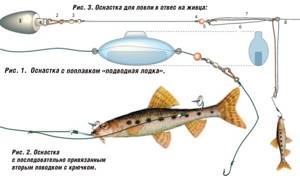
When choosing live bait, you should know that pike perch does not feed on carrion and only active “trifles” are suitable for it. A half-dead specimen is unlikely to interest a predator. Pike perch hunts mainly at night, acting from an ambush or stealthily approaching the fish. This opportunity for pike perch is given by its unique vision, which allows it to examine its prey at depth in almost complete darkness. Based on this, we can say that it is almost impossible to get away from pike perch, which is what it takes advantage of.
As a rule, fish that live in the same body of water and are part of its diet are used as live bait. As live bait you can use bleak, perch, small roach, chub or crucian fry. For this purpose, fish up to 12 cm in size, caught in the same reservoir, are suitable. You can catch live bait with a regular float rod or various gear with small cells. To catch the fry, you can make a special folding trap. To ensure that a fry or small fish is caught, bait is placed in the trap.
How to get live bait
Live bait is caught in the main fishing reservoir, using a float rod with a small hook to catch it. They catch small fish in the shallows near coastal vegetation, after feeding them with a pinch of fish feed or a crust of bread. The fry react most quickly to bloodworms and maggots. A more productive method of catching live bait is to use a net lift, or as it is called by fishermen. The lift installed on the shallows is fed with a feeding composition of a fine dust fraction and waits at the bottom for 10–15 minutes, after which it is removed to land and fry of suitable size are selected.
Important! The method of catching fry with a small fish is more productive, and live bait caught in this way are not subject to injury and live on rigs longer than similar individuals caught on a hook by an angler.
Tackle for catching large pike perch with live bait during the day, even with a minimum number of bites, will require at least three units of bait to change, which must be taken into account when collecting the required amount of live bait for fishing.
How to get live bait?
This is an important process. Before going fishing, the question of obtaining the necessary bait always arises. There are many ways to catch live bait. There are some recommendations in this regard. It is quite possible to catch future bait with a fishing rod. However, a more acceptable method is to catch live bait using a small fish. It is also known as "spider". It is a square or rectangular metal frame with a mesh with small cells stretched around the entire perimeter. To catch live bait, you need to lower the little fish into the water. After this, you should sprinkle specially prepared bait over it. It can be any porridge or bread crumbs. Then you need to wait a little and quickly remove the device from the water. In order to attract the minnow, you can agitate the mule a little. Because he prefers to live there. Small crucian carp and perch are rarely caught in the minnow. These individuals can only be caught in their habitats.
Nuances of choosing hooks
For live bait pike perch fishing, sliding doubles and single hooks with a long shank, numbers 6–8 according to the size classification line, are practical. For some combined types of fastening live baits, doubles with different hook lengths are used.
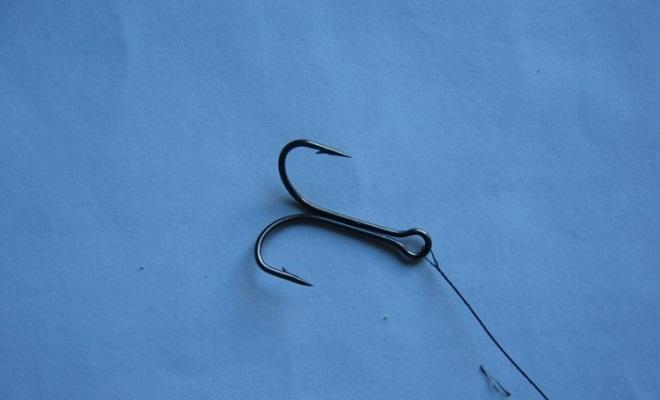
Tees are less effective because they make the rigs more massive, which alerts the fish. The hook will provide a reliable hook only if its tip is perfectly sharp. Pike perch have a bony mouth and a blunt hook, even with great virtuosity in the angler’s hooking performance, is unlikely to penetrate such protection.
Important! Each new fishing trip requires quality control of hook sharpening. Blunt hooks are sharpened using a needle file.
Hooks are available in dark tones, blue, brown and black, which better camouflages the accessory when fishing at any depth.
How to choose?
This process should be approached responsibly and rely on the existing experience of experienced fishermen. It is known that depending on the fishing method, certain types of bait are used. Namely: bottom and upper water. This is important to know. The first option of live bait is best used when fishing in mid-water in clean places. Otherwise he may get confused. The upper water one is used when fishing from the bottom in snags. You should also know one more fact. It lies in the fact that when fishing using a broach, you can always use dead live bait.
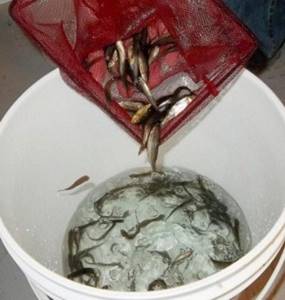
Methods for securing live bait
Methods for baiting live bait vary based on its endurance. Fish such as crucian carp, loach, gudgeon and roach tolerate installations well using a hook piercing through the back. The fry can be attached to the back in two ways, placing the hook up to the fin or closer to the tail. In rigs when fishing with a float, this type of fastener is considered classic. Attaching live bait by the lip looks more subtle. The method is used to ensure hunting at very short distances.
Important! Fishing methods that require long casting are equipped with rigs that attach the fry under the gill. This helps ensure reliable delivery of bait to the fishing area.
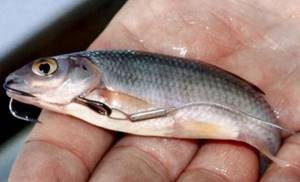
Fry that are weak in endurance, bleak, minnow, ide and chub, are secured using a rubber ring, which is placed in front of the tail on the body of the fish and the hook is set behind it. The absence of a rubber ring can be replaced by a regular thread, tied according to the principle of a mounted ring in the manner described above.
How to catch pike perch with live bait
Continuing the topic, we will consider the main and most popular methods of catching pike perch using live baits, describing the configuration of the equipment and the location of installation of the tackle in a body of water being fished for pike perch, and also highlight the most suitable hunting seasons for each method, focusing on the pike perch bite based on its intensity cycles throughout the year .
Fishing with a float rod
A float rod is a universal equipment for catching pike perch with live bait from the shore and from a boat. For the base, select a telescopic Bolognese fishing rod with a length of 4 to 7 meters with a spinning reel. Monofilament fishing line is used as a cord with a fluorocarbon leash up to 40 cm long placed at the end. Sliding weights are used, in the form of an olive. The floats are practical with a barrel-shaped body and a short antenna with the possibility of installing a firefly in its body, which will allow you to comfortably fish with live bait at night. This type of gear is used for fishing at the junctions of shallows and dumps at depths, where fish go out to hunt in the twilight and dark hours of the day. Pike perch are successfully caught using float rigs in the summer months.
Spinning fishing
Pike perch using live bait is effectively caught using a spinning rod remounted under a coastal hook. For the fishing rod, spinning rods of medium and slow action, up to three meters long, are selected. The inertia-free reel is equipped with a braided cord no thicker than 0.2 mm. A sliding flat lead weight is used with an effective mass selected according to the force of the current, and a 0.25 mm fluorocarbon leader completes this simple but effective installation for pike perch. Knit the leash directly to the cord, not forgetting to install a damper bead in front of the knot to prevent deformation of the knot by the sinker when casting the equipment. They fish riverbed pits with baitfish, where pike perch are caught especially well in late autumn, intensively fattening up for the winter season.
Fishing with bottom tackle
Bottom fishing with live bait on lakes is carried out using tackle with an elastic band, which is mounted on the bottom slopes in depth. As the main cord, braided fishing lines from 0.3 mm in diameter are used, equipping them with half-meter leads, in increments of five meters, made of monofilament or fluorocarbon 0.35-0.40 mm thick. The leashes are equipped with fixed foam floats, which should keep live bait 30–40 cm from the bottom. They catch with a rubber band all day long.
Important! If there are no bites, the condition of the live bait is checked every two hours. Read more about catching pike perch on a donka.
Fishing using the presented method is successful in the spring months, still in muddy water. Recently, lovers of pike perch hunting have increasingly begun to use feeder equipment as a bottom fishing rod. The feeder is equipped with a feeder using chicken or beef liver as bait, as well as finely chopped fresh fish, which stimulates more predators to approach the catching point. For installation, sensitive knitting of the inline type is practiced. The feeder shows its prey activity in the summer months, especially in July and August, which is passive in terms of pike perch activity.
Fishing with mugs and girders
The classic live bait tackle for large pike perch is considered to be a circle set with the current over promising sites for pike perch. The mugs are equipped with a 0.25 mm monofilament line without the use of a leash, with an olive weight stopped 40 cm from the hook. Live bait is released 60–100 cm from the bottom. The work of the circles is monitored by a boat moving behind the squadron of fishing devices. The method is effective throughout the open water season.

Stationary zander poles are placed from the shore or from a pole in the water near promising pike-perch points. Equipping a fishing device with a cord, a weight and the method of installing live bait in the water horizon is similar to a floating circle. There is a design for a winter ice trap with a bite alarm in the form of a rising flag. Winter, as well as summer, stationary girders can be successfully used for round-the-clock fishing, monitoring only the activity of the live bait mounted on the hook, which is done at least at three-hour intervals, and monitoring bites.
Pike fishing spots
A place for pike fishing should be chosen depending on the time of year. Its behavior differs in different periods, and therefore its usual habitats and hunting areas also differ.
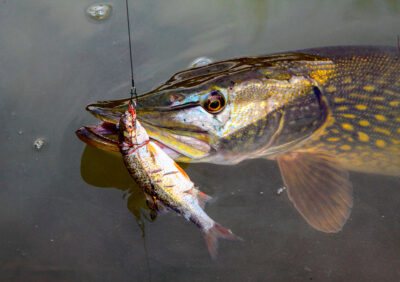
In the spring, this ferocious predator hunts in shallow areas of the reservoir, where there are many small fish. You need to look for it where there are thickets. In such places, he sets up an ambush and after the fry comes into his field of vision, he immediately goes on the attack. The pike chooses a place for an ambush in such a way that it is not visible behind the vegetation, but at the same time, so that the view is as good as possible. Therefore, it is best to catch pike with live bait in overgrown areas or close to them.
On rivers, the predator likes to hunt in channel edges, at the entrances and exits of pits, and in pools. If a lake has been chosen for fishing, then special attention should be paid to the places where streams and rivers flow into the lake. Pike also likes to stand at changes in depth, near submerged snags and aquatic vegetation.
In summer, pike fishing with live bait from the shore can be carried out throughout the entire area of the reservoir. At the exits and entrances to pits, in snags, the chances of catching a toothy fish will be greater. Also, more attention should be paid to areas with depth differences and slower flow speeds. There are more fry there, and, accordingly, pike will be caught better with live bait in the summer.
In autumn, pike lie in wait for their victims at the boundaries of depth changes. In such places, in the morning its potential prey swims out into shallow water, and in the evening it returns to the recesses.
